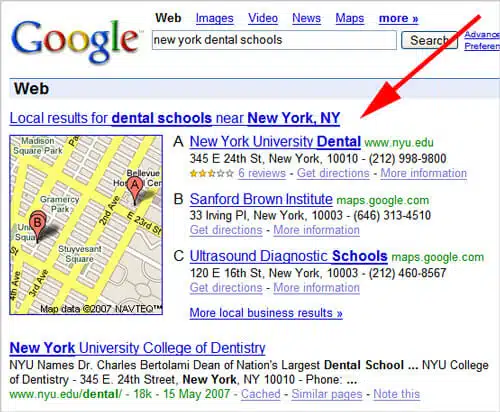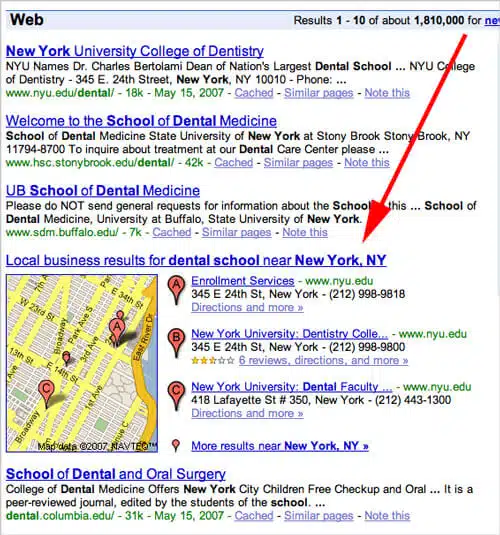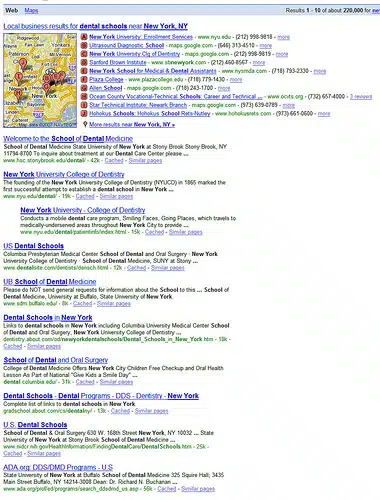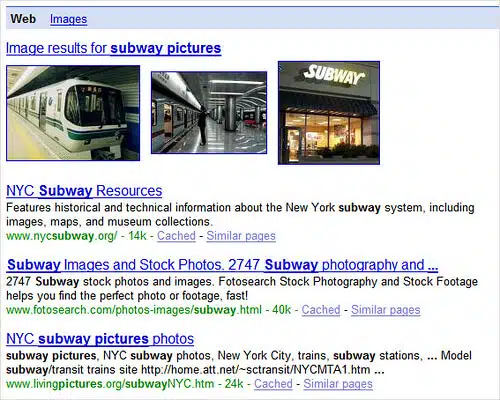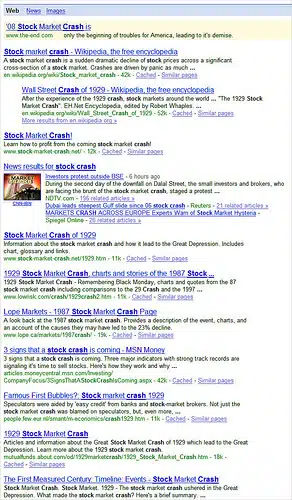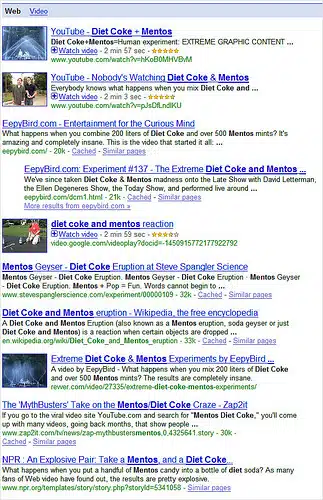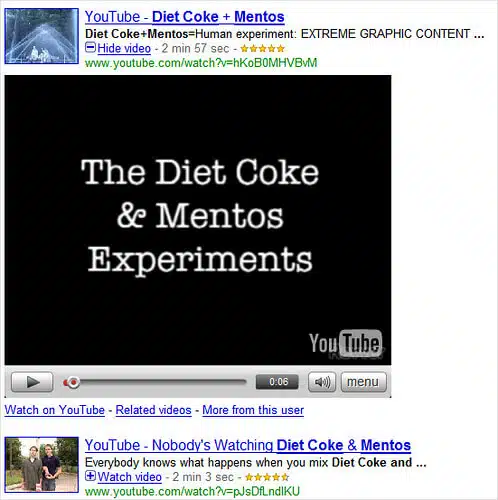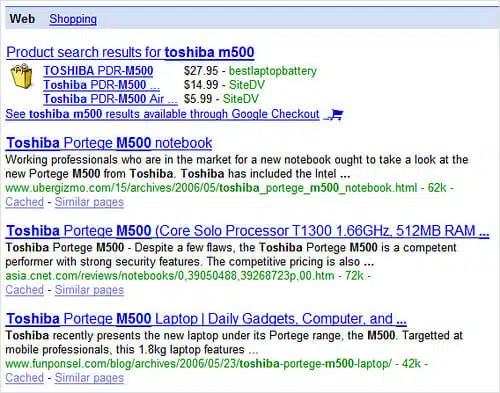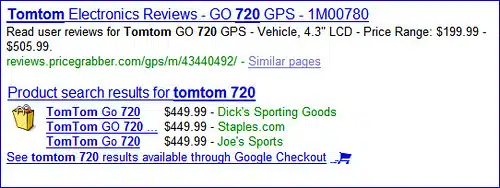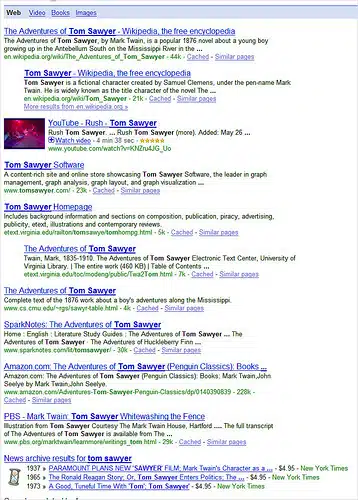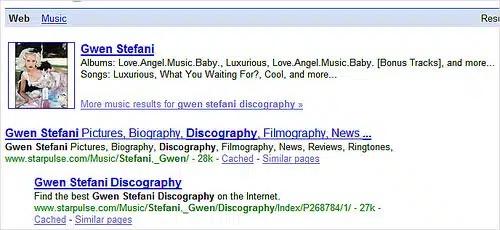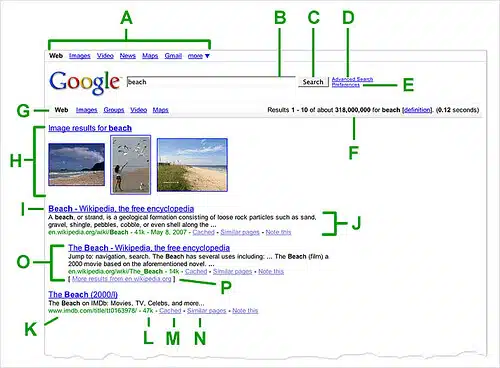Google Universal Search Expands
It’s just over a half-year since Google launched Universal Search, its method of blending results from its own various topically-focused or “vertical” search engines. Since that time, the system has evolved. In particular, Google Universal Search now fills more than just 10 spots on the page, while shopping and blog search results are among new […]
It’s just over a half-year since
Google launched
Universal Search, its method of blending results from its own various
topically-focused
or “vertical” search
engines. Since that time, the system has evolved. In particular, Google
Universal Search now fills more than just 10 spots on the page, while shopping
and blog search results are among new resources being included. Below, a look at
these and related changes.
The Big Picture: Comparative Ranking & Blending
With Universal Search, Google promised that two major things would happen:
- Comparative Ranking
- Blending
Before Universal Search, Google gave a list of 10 web search results — the best
10 selected by measuring those pages against all the web pages in the Google
index of billions. Separately, Google decided if other information should be
added to the search results page using different mechanisms.
For example, if you got web search results with news headlines above them, the
headlines did NOT appear because Google tried to determine if the news results
were more relevant than the web search results. It gave you web results, and a
different process independently decided if news results should be added.
Universal search changed this. In it, Google said that web search results were
measured directly against other types of search results, such as images or news.
If those results were deemed more relevant than web search, then they’d be added
to the page. That’s the comparative ranking part.
Google also typically would take away a web search listing if comparative
ranking decided that a vertical search listing should go on the page. That’s
the blending part. For example, news results might instead be “blended”
within the regular 10 listings area, perhaps at position four, or six, or
wherever, rather than always being put at the top.
Comparative Ranking Sources Expand & Blending No Longer Subtracts
When Universal Search launched, comparative ranking ran against these vertical or specialized search engines as well as web search:
- Web Search
- Book Search
- Images
- Local/Maps
- News
- Video
Since around December, Google says two more vertical search engines have been added to the list:
As for blending, also toward the end of last year, this changed. No longer was it a case of a one-to-one replacement, where a web search listing had to go away to make room for a
vertical search listings. That can still happen, but it’s also the case that blending can mean adding vertical results to the web search results, without taking some of the web search listings away.
Revisiting Blending: Local Search
It’s easiest to explain some of the blending changes with real examples, so let’s take a
look. I’ll start with a local search, for
new york dental
schools. When that search was done after Universal Search first rolled out,
the results looked like this:
As you can see, they were positioned at the top of the page. Immediately after Universal Search, they might still appear at the top of the page, but they also sometimes go
blended further down, like this:
Notice how the local search box is in the middle of the page? That’s because,
at the time, Google decided that after looking at all the various vertical and
web search results, local results were fourth in overall relevancy.
In addition, if you could see the entire page, you’d notice that there are 10
listings in all. The first three are above the local listings, then the A, B, & C listings
next to the local box counted as results 4 through 6. After the box, there were four more listings — 10 in all. The local listings caused three of the web search listings to get removed.
Here’s how it looks today:
Super-Size My Blended Results
Notice how there are 10 local listings at the top (a
recent change from
the three local listings that used to be shown), followed by 10 web search listings after that. That’s 20 listings in all. In “traditional” Universal Search, there should only be 10. But traditional is gone. Google now will super-size the results and go beyond 10, if it feels that’s appropriate. Said David Bailey, tech lead for Google, on Universal Search:
We’ve found there are times when an individual result from one of our
verticals simply belongs amongst the main list of results, with little fuss made
about how it’s different. Other times, what’s important is that there’s a bunch
of relevant content from that vertical, and in those cases we think of it as a
search refinement option that’s enhanced with a results preview, and so it’s
shown in addition to the main list rather than displacing results from it.
It’s not just local results that may get added to the results page, without
taking away web search results. Other vertical search results get added as well,
as will be seen further below.
Blended Means Top, Bottom & In Between!
Did you notice the local search results are back at the top of the page, just
like they often appeared before Universal Search rolled out? Seeing it there,
you might wonder what happened to all that “blending” that supposedly was going
on.
Johanna Wright, who heads up Google’s search user interface group, says that
removing a web search result and blending a vertical listing into the top 10
list will still happen. But she also stressed that blending also means putting
vertical content on the page in addition to the list, perhaps at the top and
bottom, especially if users will react to certain types of content better there:
If we think we need to call something out, we say “Hey, look at news, images,
books” [by inserted at the top or bottom]. If we think ranking makes more sense, then we don’t do the call out
[and results are blended].
With local search, a display at the top of the web search results is most
common. However, sometimes a local search unit will be interleaved into the top
10 web listings, taking the place of one of them.
More Examples: Image Search Blending
Let’s see some more examples of Universal Search in action. Here’s a search
for subway
pictures:
As you can see, Universal Search is putting the images at the top of the
page. On rare occasions, I’ve seen image search results come at the
bottom. But top display pretty much seems standard. In addition, image search always seems to be additive — i.e., you get image search results, plus 10 other results — 11 listings, in all (or 13 listings, if you count each image shown as a separate listing).
News Search Blending
How about news? Like image search, you’ll often see it at the top, as with
this search for
interest rates:
As with image search, the news box is additive — you get it in addition to
10 other listings. But the placement isn’t always the same. Consider a search
for stock crash:
Here, the news box comes in position four. But despite the blending, the box
remains additive. Count all the unpaid listings, including the news box, and
you’ll see there are 11 in all. In “old” universal search, there would have been
only 10.
Book Search Blending
Book Search blending is difficult for me to show, because it simply doesn’t
seem to be working consistently. Consider these searches that I thought would
have brought up some Google Book Search content:
-
he does not number the streaks of the tulip -
i know that i shall meet my fate somewhere in the clouds above -
her wan, scornful mouth smiled, and so I drew her up again closer - Othello
-
The Moon Is A Harsh Mistress
quiver river state park
The last one DID bring up Google Book Search results when I last looked at
Universal Search, and the others are all places I’d have expected it to kick in.
Google’s chalked it up to data center issues, though Search Engine Land
contributing editor Greg Sterling had problems seeing Google Book
Search blending in California just as I did when I was searching from the UK.
Google says that book search results will sometimes be blended by taking away
a web search listing, such as with
how to draw
birds or
kinakuta
palawan borneo. Other times, a special book search box makes more sense to
appear at the top of results (as with
toni morrison) or at
the bottom (as with
differential equations).
Video Search: Fully Blended
Half-a-year on, it is video search results that are the most “blended” in
terms of being mixed among web search results in the top ten list. Consider this search for
diet coke
and mentos:
Everywhere you see a thumbnail image, that’s a video result pulled from
Google Video. In addition, these results
are subtractive. For any video listing coming from Google Video, a web search
result is pulled and replaced. Count them up, and you’ll see there are 10
results in all.
As with the launch of Google Universal Search, you can play video right
within the search results, if that video is hosted by Google-owned YouTube or
Google Video. You just click on the + symbol next to the words “Watch video” to
open up the player:
Video not hosted by Google
still cannot be
played inline. Why not? Said Google:
We’re still streaming only Google Video and YouTube content because that remains
the best way for us to ensure a certain quality of experience for users.
Also, back when Google Universal Search launched, we covered then and in follow-ups like
Google Video Morphs
Further Into New Video Meta Search Role how Google Video was listing video
content from across the web, rather than just from Google. Since then, Google
Video now encompasses hundreds of sources for video content, Google said.
Product Search: Top & Bottom
Product search is one of the two new additions to Universal Search. Product
search unites may appear at the top of the
page like this for
toshiba m500:
Alternatively, if not deemed as relevant as other listings but still
important, they may come at the bottom like
this for tomtom 720:
Blog Search At The Bottom
Blog search is the other new addition to Universal Search. Google says that
right now, blog search will always appear at the bottom of the page, like this
for stock market:
Blog & Being Fresh In General
Results in the Blog Search box come from
Google Blog Search, which can pull
content from a submitted feed in
within seconds,
if you’ve
pinged the service. That means when the box appears on the Google search
results page through Universal Search, Google can seem very fresh.
Of course, even without the box, Google has gotten fresher. Certain blog home
pages are regularly crawled independently of Google Blog Search, just as there
are news sources and even ordinary web sites that are subject to rapid crawling
and insertion into the index.
Many SEOs will know Google has various crawlers using names corresponding to
services like news or blog search, as well as Googlebot for the general crawl.
But actually, all these crawlers are part of the same centralized system. They
may report different names, but the content all generally flows back into
Google’s index to be sliced and diced as appropriate.
The centralized system will hit news sites frequently, because that’s what
you need to do to keep news content fresh. Blog search continues to take in only
whatever is put out in a feed, so that it doesn’t have complete information for
sites that use partial feeds. Pages like this only get updated when a regular
crawl happens.
That regular crawl, however, can be faster for sites that Google has either
algorithmically or with human review decided should be part of its “instant
layer.” These are sites where pages are fully crawled within hours or less of
posting. For example, here’s a page we wrote about on the
Google Oogle Sari
that is showing up only a few hours after being posted:
You can see in the description that it was found six hours ago, at the time I
did the search — and it was probably showing up well before that.
Minty Fresh
Indexing from Matt Cutts and
Finding fresh results from the Official Google Blog talked in the middle of
last year about the freshness change. Some seeing this have
mistakenly assumed that the entire Google index is refreshed within minutes.
It’s not — they’re fast, but not refresh tens-of-billions of documents in
minutes fast!
Blended Weirdness
So far, I’ve shown examples of one type of vertical result being blended.
More than that can flow in. Consider this search for
newport beach
pictures:
In it, you can see how image search comes first, followed by local results,
followed by 10 web search results. That’s three types of content blended, with
12 to 16 listing in all, depending on if you count each image and each local
search result as a separate listing.
Now consider this search for
tom sawyer:
In position three, you’ll see a blended video result. Then at the bottom,
there are news archive results.
Google News Archive search is NOT part of Google News Search and is NOT part
of the Universal Search blending system. So, what’s it doing there? And what
about things like this, where for
gwen
stefani discography, a
Google Music
unit appears:
Where Have All The OneBoxes Gone?
In the past, I would have called the examples above of Google Music Search
and Google News Archives “OneBoxes” and pointed to
this reference in the Google home page to explain them more:
H. OneBox results
Google’s search technology finds many sources of specialized information.
Those that are most relevant to your search are included at the top of your
search results. Typical OneBox results include news, stock quotes, weather and
local websites related to your search.
However, that explanation of what OneBoxes are was
last seen in May, before Universal Search rolled out. Today, it’s been
replaced with this:
H. Integrated results
Google’s search technology searches across all types of content and ranks the
results that are most relevant to your search. Your results may be from
multiple content types, including images, news, books, maps, and videos.
So, are OneBoxes gone? Are these things part of Universal Search too?
No, they’re not. Again, Universal Search only pulls content from these
sources and decides if, when, and how to blend into the page:
- Web Search
- Book Search
- Images
- Local/Maps
- News
- Video
- Blog Search
- Product Search
Beyond these, Google has other vertical search engines and
special features
such as
flight tracking,
weather conditions, and more. These continue to be placed on the page
according to decisions made by other search algorithms.
Who Cares How It’s Blended?
Does it matter? To the searcher, probably not. Said Wright:
From my perspective, I think of this all as universal search, where we try to
get the best stuff on the page. We look at all the backends, deciding how to
blend and where to order it.
In general, I agree with Wright. Universal Search is a good term to apply to
the entire concept that Google is blending a lot of different information into a
single search results page. And as long as the searcher gets a page that seems
relevant, they don’t care how it is done.
But for the hard-core searcher and search marketer, it’s has been helpful to
know what’s been coming off Universal Search when it was in a more “subtractive mode” in
the past — when it would take away web search results and replace them with
vertical listings.
Now that this has largely changed, the main reason to still know if it is
Universal Search actually in action is that Google itself made a fairly big deal
on how smart Universal Search is in terms of comparative ranking.
Before Universal Search and the
blended search / Search
3.0 era, search engines were already blending vertical results and
shortcuts above regular listings or in other places on the page. Google said
Universal Search was going a step beyond and making comparative relevancy decision across
multiple data sources. But competitors pushed back that Universal Search wasn’t
so smart. To understand, consider what
I wrote about
video blending at Google, which is most noticeable because of the thumbnails:
It’s also something that has Google competitors upset. They show video
content that’s listed on web pages in their regular search results. Adding
thumbnails and enhancing these “web” listings wouldn’t be difficult. So they
don’t see what Google is doing as that unique.
Yahoo says ‘Been there, done that’ to Google redesign from News.com gets
into this more.For its part, Google has explained that it is not simply flagging video on
web pages for enhancement. It stresses that it is searching against an
entirely different video database to decide of the results there are of
greater relevance than a web page listing. If so, the web page listing gets
yanked. That is more sophisticated — yet the end results might not be that
different than just inserting thumbnails for web pages that you can tell also
have video.
Who Cares How It’s Blended?
Even though web search results are no longer being yanked or removed as much
as in the past, Google stresses that Universal Search is still indeed smart and
in action guiding all types of blending. It also stressed that the exact
nature of blending is likely to continue evolving. Some of this is even already
seen in
tests that were spotted late last year, where vertical results were
showing up in a right column, similar to how Google’s test bed
SearchMash
operates, not to mention the
Ask3D display that
Ask moved to last year. Said Wright of the changes and evolutions:
The top ten list may not support all of them [vertical search results that
Google wants to display]. We’re ready to bust through with more types of content, and the
current user interface might need to change to support them. We’re experimenting
with right-hand side placement as you noted, as well as other ideas coming down
the pike. While we don’t know exactly how it will evolve, we’re quite sure that
there will remain a strong ranking component to the choice and layout of groups
on the page, especially as we continue to increase coverage for many of the
verticals.
Contributing authors are invited to create content for Search Engine Land and are chosen for their expertise and contribution to the search community. Our contributors work under the oversight of the editorial staff and contributions are checked for quality and relevance to our readers. The opinions they express are their own.
Related stories
New on Search Engine Land
